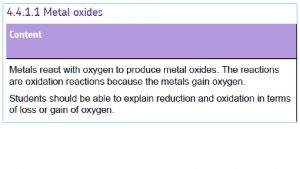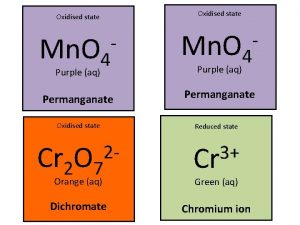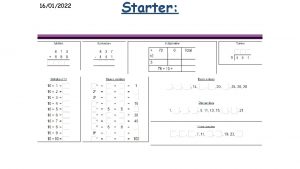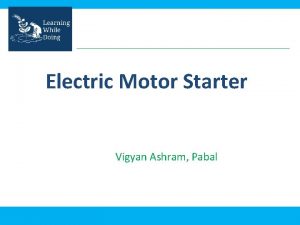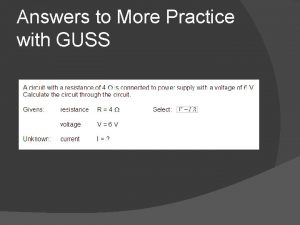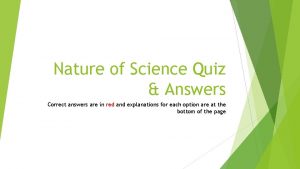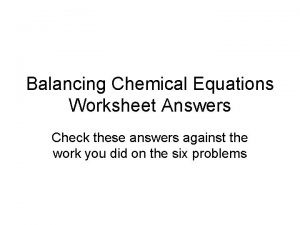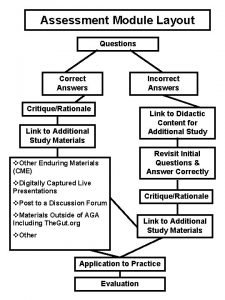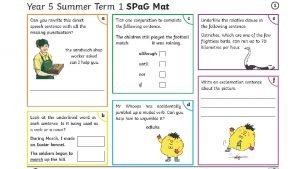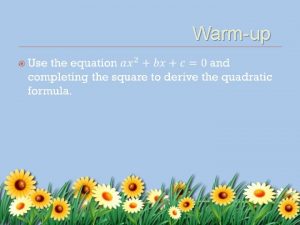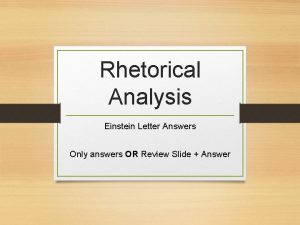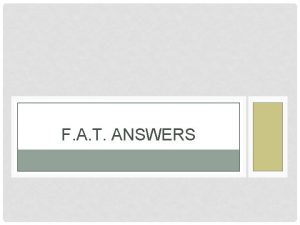Starter for 10 Answers 1 a Zn oxidised


























- Slides: 26

Starter for 10


Answers 1 a) Zn oxidised b) Zn 2+ + 2 e- Cu reduced Cu 2+ + 2 e- Cu 2 a) Oxidised b) Reduced c) Neither d) Reduction e) Oxidised f) Neither 3 a) Fe Loses 2 electrons to bond with sulfate ion b) Na loses 1 electron to bond with hydride ion c) Cu(s) loses 2 electrons to bond with oxygen ion d) Fe loses 1 electron (goes from Fe 2+ to Fe 3+) e) Zn loses 2 electrons

Task • Chemsheets Oxidation States and Redox • Part A “Oxidation States”


What are Half Equations? • They show the GAIN or LOSS of e- by one chemical. E. g. , FULL EQUATION for sodium reacting with chlorine: 2 Na(s) + Cl 2 (g) → 2 Na. Cl(s) Each sodium atom is losing an e- so you could write a half equation: Na → Na+ + e • Each chlorine atom in a chlorine molecule gains an e-, so you could write a half equation: Cl 2 + 2 e- → 2 Cl(You must show 2 chloride ions because each chlorine molecule, Cl 2, contains 2 chlorine atoms)

Your Turn 2 Na(s) + Br 2 (g) → 2 Na. Br(s) Write the half equation for: 1. Sodium 2. Bromine

Your Turn 2 Na(s) + Br 2 (g) → 2 Na. Br(s) Write the half equation for: 1. Sodium Na → Na+ + e- 2. Bromine Br 2 + 2 e- → 2 Br-

Spectator Ions Zn (s) + Cu. SO 4(aq) → Cu(s) + Zn. SO 4 (aq) Each Zinc atom is oxidized: Zn (s) → Zn 2+(aq) + 2 e. Each Copper ion is reduced: Cu 2+(aq) +2 e- → Cu(s) Which on es are sp ectator ions? Ones tha t: • Are not oxidized or r • Do not c hange sta educed te from soli d to aq so (e. g. , lution) clude? n i I o d s The sulfate ions SO 4 not appear in the equations. Which one t: They do not change during the reaction. Ones tha are oxidized or that e s o h T • They are dissolved in water so are just floating ate t reduced. s e g around. n a h at c • Those th 2 - so They “watch” the reaction - spectator ions.

Check Your Understanding so Far Write half equations for these changes: 1. An iodide ion changes into iodine 2. A fluorine molecule changes into fluoride ions. 3. A potassium atom changes into a potassium ion. 4. A barium atom changes into a barium ion 5. An aluminium ion is changed into an aluminium atom. EXT: State whether each half equation is showing oxidation or reduction.

Check Your Understanding so Far Answers 2 I- I 2 + 2 e. F 2 + 2 e- 2 FK K+ + e. Ba 2+ + 2 e. Al 3+ + 3 e- Al

Working out Half Equations 1. The numbers of atoms on each side of the equation must be the same. 2. The total charge on each side of the equation must be the same a) Calculate oxidation states on each side of the equation. b) Balance the element changing oxidation state. c) Sort out electrons. If the oxidation state becomes more negative then it gains electrons. If the oxidation state becomes more positive then electrons are lost. d) Sort out Os. For every O gained/lost, add/remove one H 2 O molecule. e) Sort out Hs. For every H gained/lost, add/remove one H+ ion. f) Check – if the total electric charge on the left equals that on the right then it is probably correct. If it is not then you know that you have gone wrong!



Task • Chemsheets Task B Q 3


Combining Half Equations • • • Step 1: Write out the 2 half equations Step 2: Note the number of e- each half equation gains or loses. So that both equations involve the same number of e-, you may have to multiply up one or both equations. Step 3: Multiply up the reactants and products. Step 4: Write all the reactants together and the products together. Step 5: There should be the same number of e- on each side of the equation. Cancel them. What is left behind is the full balanced equation.

Example

Task • Chemsheets C: Combining equations Q 4


Overall notes Any redox reaction divided into 2 half equations: One represents Oxidation and the other Reduction. 1. Balance with respect to MASS A) Element being ox or red B) Any oxygen molecules with water molecules. C) Hydrogen atoms in water with H+ ions 2. Balance with respect to CHARGE using e(to check how many e-, see the change in oxidation state). 3. To get the FULL overall redox equation A. Balance no of e- in each half equation B. Add together and the e- will cancel.

TIPS: Half-Equations • Balance the number of atoms • Balance the number of charges • Always have rather than “‒ e-” in • They show the LOSS or GAIN of e- by one“+e-” substance. your half-equations • They can be recombined to give your full • E. g. , equations again • FULL EQUAITON: • If you have a different number of electrons, MULTIPLY each equation by a • Mg(s) +factor Cl 2 (g)that → Mg. Cl (s) you equal numbers of will 2 give electrons in each one • 2 half-equations: • • An Oxidation Reaction A Reduction Reaction Mg → Mg 2+ +2 e. Cl 2 +2 e- → 2 Cl-

Example • Combine these 2 half-equations: Al 3+ + 3 e- → Al (Multiply by 4 to get 12 e- 4 Al 3+ + 12 e- → 4 Al) 2 O 2 - → O 2 +4 e(Multiply by 3 to get 12 e. OVERALL: 4 Al 3+ + 6 O 2 - → 4 Al + 3 O 2 6 O 2 - → 3 O 2 +12 e-)

Quick Check … 1. Work out the oxidation state of the underlined element in a. SO 2; PCl 3; Na 2 S 2 O 3 b. S 2 -; Cl. O 3 -; PCl 4+ 2. Zinc reacts with copper chloride Zn + Cu. Cl 2 → Zn. Cl 2 +Cu Write 2 half-equations, and identify which species is oxidised and which one is reduced. 3. Combine these 2 half-equations Al → Al 3+ + 3 e- and Cl 2 +2 e- → 2 Cl-

Task • Complete the Redox Reactions worksheet

Exam Questions
 Fspos
Fspos Novell typiska drag
Novell typiska drag Tack för att ni lyssnade bild
Tack för att ni lyssnade bild Ekologiskt fotavtryck
Ekologiskt fotavtryck Varför kallas perioden 1918-1939 för mellankrigstiden
Varför kallas perioden 1918-1939 för mellankrigstiden En lathund för arbete med kontinuitetshantering
En lathund för arbete med kontinuitetshantering Adressändring ideell förening
Adressändring ideell förening Tidböcker
Tidböcker Sura för anatom
Sura för anatom Vad är densitet
Vad är densitet Datorkunskap för nybörjare
Datorkunskap för nybörjare Boverket ka
Boverket ka Debatt mall
Debatt mall Delegerande ledarskap
Delegerande ledarskap Nyckelkompetenser för livslångt lärande
Nyckelkompetenser för livslångt lärande Påbyggnader för flakfordon
Påbyggnader för flakfordon Formel för lufttryck
Formel för lufttryck Offentlig förvaltning
Offentlig förvaltning Jag har nigit för nymånens skära text
Jag har nigit för nymånens skära text Presentera för publik crossboss
Presentera för publik crossboss Vad är ett minoritetsspråk
Vad är ett minoritetsspråk Kanaans land
Kanaans land Klassificeringsstruktur för kommunala verksamheter
Klassificeringsstruktur för kommunala verksamheter Epiteltyper
Epiteltyper Claes martinsson
Claes martinsson Centrum för kunskap och säkerhet
Centrum för kunskap och säkerhet Byggprocessen steg för steg
Byggprocessen steg för steg




























